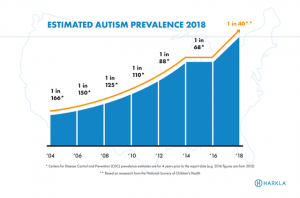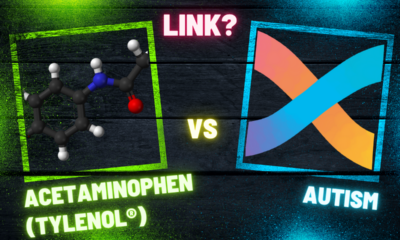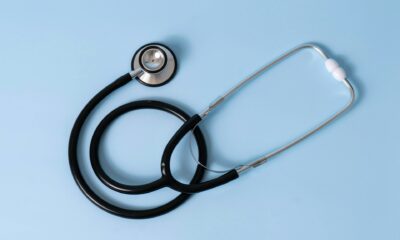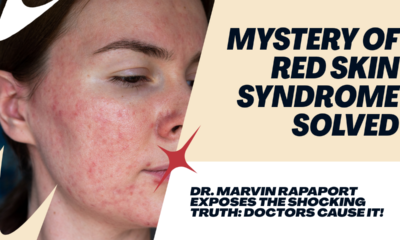Guest Columns
Autism—still looking for answers in all the wrong places
Autism spectrum disorders are more prevalent and occur more often than ever. Once again: could overuse of ultrasound be the culprit?

According to 2018 statistics from the Center for Disease Control (CDC), about 1 in 59 children has been identified with autism spectrum disorder (ASD), up from the one in 68 in 2016.
This updated CDC chart—from 2019—reveals the shocking escalation of autism in the U.S., which is predicted to be one in every 40 children in the near future.

Autism statistics: plus ça change…
As always, the powers-that-be at the CDC trot out the age-old rationales to explain these disturbing statistics:
- Greater awareness and therefore earlier and more accurate diagnoses
- The role that being older parents play not only in the incidence of autism but also Down syndrome and other developmental disabilities
- Genes
- “Something” in the environment
Racial differences in autism?
Five years ago, a CDC study found that the incidence of autism in blacks “continues to lag behind whites and Hispanics,” which some experts attributed to racial bias—i.e., blacks lack equal access to medical care. But other experts say that blacks may simply be less vulnerable to autism for some unknown reason.
What is consistently omitted, however, is the role that ultrasound exams during pregnancy may and probably do play in the rapidly-escalating incidence of this lifelong condition.
Autism: what we know today
Autism is a neurological disorder that affects the normal development of the brain, causing self-defeating behaviors and an inability to form social relationships. It usually appears before the age of three. Most scientists believe that autism is strongly influenced by genetics but allow that environmental factors may also play a role.
To be diagnosed on the autistic spectrum, a child must have deficits in three areas:
- Communication (most children can’t make eye contact; others can’t speak).
- Social skills (typified by disinterest in both people and surroundings).
- Typically “normal” behavior (many autistic children have tics, repetitive behavior, inappropriate affects, et al).
Those diagnosed on the autistic spectrum range from high-functioning, self-sufficient people—even geniuses—to those who need lifelong supportive help.
A largely-debunked theory: vaccine preservatives
The increased incidence of autism has been attributed by legions of parents and a number of professionals to the mercury-containing preservative thimerosal, used to prevent bacterial or fungal contamination in the vaccines babies and children routinely receive.
This is not backed up by hard science.
Thimerosal no longer used
Thimerosal, which has been used in vaccines since the 1930s, has not been used in the U.S. since 2001 and the vaccine dosages containing the preservative that were given before then had about the same amount of mercury found in an infant’s daily supply of breast milk.
Numerous studies—by The CDC, The Institute of Medicine, The American Academy of Pediatrics, The World Health Organization, and The National Academy of Sciences, among other prestigious organizations—have found no autism-vaccine link, while other studies have shown an increase in autism in countries that have removed thimerosal from vaccines.
In fact, between late 1999 and late 2002, mercury was removed from most childhood vaccines, including DPT (Diphtheria, Tetanus, Pertussis), Hepatitis B, and Hib [Haemophilus influenza b]. The MMR (Measles, Mumps, Rubella), which is a live vaccine, is not compatible with thimerosal.1
Autism up, other neurological diseases down?
What appears significant, however, is the degree to which diagnoses of mental retardation and learning disabilities throughout the country have decreased at the same time as diagnoses of autism have risen, as reported in a May 2006 issue of Behavioral Pediatrics.
Some experts theorize that “diagnostic substitution” may explain this phenomenon. Diagnostic Substitution means that children who were diagnosed with other conditions—including ADHD and learning disabilities—are now diagnosed with autism.
My theory and observations concerning autism and its incidence
In the early ’70s, i worked as a delivery-room nurse at a university-affiliated hospital. It was a revolutionary time in obstetrics, when the Lamaze method of “prepared childbirth” and the use of sonograms to visualize fetuses in the womb were just gaining popularity.
Ultrasound technology was first developed in Scotland in the mid-1950s by obstetrician Ian Donald and engineer Tom Brown to detect industrial flaws in ships. But it was only in the early 1970s that it was used in American hospitals to check that the developing baby, placenta, and amniotic fluid were normal and to detect abnormal conditions such as birth defects and ectopic pregnancies, et al.
Increasing use of ultrasound
At the end of the ’70s, I became a certified Lamaze teacher and spent the next 22 years giving classes in my home. In a very real way, I had my own laboratory, as I learned directly from my clients about the increasing escalation of sonogram exams.
In the early 1980s, it was common for only one or two out of the 10 women in my classes to have a sonogram. In just a few years, every woman in my classes had had a sonogram. And in the late ’80s and ’90s, almost every woman had not one but often two or three or four or five sonograms—starting as early as three-or-four weeks of gestation and extending, in some instances, right up to the ninth month!
A pattern emerges
It was in the ’90s, in fact, that it began to occur to me that the scary rise in the incidence of autism might be linked to the significant rise in ultrasound exams. Over the years, I’ve posited my theory to a number of people and written letters to the editors of newspapers—including the NY Times, for which I wrote for over 20 years, but they still refused to publish my letter.
I contacted autism researchers Dr. Marcel Just and Dr. Diane L. Williams, who told me via e-mail that Dr. Pasko Rakic at Yale was, indeed, exploring the autism-ultrasound link.
An Aha! Moment
Then, in 2006, I found an article in Midwifery Today: “Questions about Prenatal Ultrasound and the Alarming Increase in Autism,” by writer-researcher Caroline Rodgers.
“The steep increase in autism,” Rodgers wrote, goes beyond the U.S.: it is a “global phenomenon”… that “has emerged…across vastly different environments and cultures.”
Where does the increased incidence of autism come from?
“What do countries and regions with climates, diets and exposure to known toxins as disparate as the U.S., Japan, Scandinavia, Australia, India and the UK have in common?” Rodgers asked.
“No common factor in the water, air, local pesticides, diet or even building materials and clothing can explain the emergence and relentless increase in this serious, life-long neurodevelopmental disorder,” she stated.
What they do have in common
“What all industrial countries do have in common,” she added,
is … the use of routine prenatal ultrasound on pregnant women. In countries with nationalized healthcare, where virtually all pregnant women are exposed to ultrasound, the autism rates are even higher than in the U.S., where due to disparities in income and health insurance, some 30 percent of pregnant women do not yet undergo ultrasound scanning.
Competing theories of cause of autism
The cause of autism, Rodgers continues,
has been pinned on everything from “emotionally remote” mothers…to vaccines, genetics, immunological disorders, environmental toxins and maternal infections, [but] a far simpler possibility…is the pervasive use of prenatal ultrasound, which can cause potentially dangerous thermal effects.
Enter hard science
In August 2006, Pasko Pakic, M.D., chair of Yale School of Medicine’s Department of Neurobiology, announced the results of a study with pregnant mice undergoing various durations of ultrasound. The brains of the offspring showed damage consistent with that found in the brains of people with autism.
The research, funded by the National Institute of Neurological Disorders and Stroke, also implicated ultrasound in neurodevelopmental problems in children, such as dyslexia, epilepsy, mental retardation and schizophrenia, and showed that damage to brain cells increased with longer exposures.
More than this one study shows the link
Dr. Rakic’s study, Rodgers said, “… is just one of many animal experiments and human studies conducted over the years indicating that prenatal ultrasound can be harmful to babies.”
Jennifer Margulis, author of Business of Baby: What Doctors Don’t Tell You, What Corporations Try to Sell You, and How to Put Your Baby Before Their Bottom Line, writes that Dr. Rakic “concluded that all nonmedical use of ultrasound on pregnant women should be avoided.”
Overexposure, or just at the wrong time?
In her research, Margulis discovered that “there is mounting evidence that overexposure to sound waves—or perhaps exposure to sound waves at a critical time during fetal development—is to blame for the astronomic rise in neurological disorders among America’s children.”
Problems with sound and heat, and how they might induce autism
A 2009 Scientific American article by John Slocum explains that sonar—Sound Navigation And Ranging systems—first developed by the U.S. Navy to detect enemy submarines,
generate slow-rolling sound waves topping out at around 235 decibels, [while] the world’s loudest rock bands top out at only 130. These sound waves can travel for hundreds of miles under water, and can retain an intensity of 140 decibels as far as 300 miles from their source.
Effect on whales and dolphins
This is relevant because many mass deaths and strandings of whales
and dolphins have been attributed to the sonar waves emitted from
Navy ships. As
many as 3,000 dead dolphins were found in Peru during the summer
of 2012, which researchers attributed to the deep-water sonar by
ships in nearby waters. And
in June of 2008, four days after a Navy helicopter was using
sonar equipment in training exercises off the coast of Great Britain,
26 dolphins died in a mass stranding.
Quick question: If
sonar beams can kill fully-developed dolphins, what effect do they
have on the developing brains of in-utero embryos and fetuses in the
first three months of development?
What does ultrasound actually do?
Rodgers explained that ultrasound used in fetal imaging emits high-frequency sound waves that are converted into images and waves that can heat both tissue and bone.
She cited a warning the Food and Drug Administration issued in 2004:
…even at low levels, [ultrasound] laboratory studies have shown it can have… “jarring vibrations” – one study compared the noise to a subway coming into a station – “and a rise in temperature.”
Imagine how these assaults affect the fragile brain of a developing fetus!
How long have they known this?
Just as concerning, as far back 1982, a study by the World Health Organization (WHO)—“Effects of Ultrasound on Biological Systems”—concluded that
…neurological, behavioral, developmental, immunological, hematological changes and reduced fetal weight can result from exposure to ultrasound.
The heat problem
Two years later, the National Institutes of Health (NIH) reported that when birth defects occurred, the acoustic output [of sonograms] was usually high enough to cause considerable heat.
And yet, in 1993, the FDA approved an eight-fold increase in the potential acoustical output of ultrasound equipment, ostensibly to enhance better visualization of the heart and small vessels during microsurgery. Clearly, the health and well-being of developing fetuses was not a consideration!
“Can the fact that this increase in potential thermal effects happened during the same period of time that the incidence of autism increased nearly 60-fold be merely coincidental?” Rodgers asks.
Keeping the heat on (so to speak)
In 2010, Ms. Rodgers presented a lecture about autism and ultrasound entitled “The Elephant in the Room” at the Interagency Autism Coordinating Committee of the U.S. Department of Health and Human Services. These were but a few of her shocking conclusions:
- A worldwide autism boom was identified by the Environmental Protection Agency (EPA) that began in 1988-1989.
- Ultrasound use and autism are more prevalent among higher socioeconomic groups.
- An increased prevalence of autism occurs among better-educated, more affluent communities. Among other things, women in these communities have more ultrasound exams.
Risk factors for autism go along with ultrasound exposure
Women who are at higher risk of bearing children with autism include mothers who:
- Receive first-trimester care
- Have higher educations
- Have private health insurance
- Are older
Rodgers concludes: Only increased exposure to prenatal ultrasound can explain all of the above.
Those who disagree with the autism and ultrasound link
Numerous studies “prove” fetal ultrasound exams are safe, like the recent study reported in The Journal of the American Medical Association, which essentially said no problem!
In addition, WebMD touts the benefits of the technology, including that sonograms depict 4D imaging which vividly presents “the baby’s in utero facial expressions.”
The U.S. Food and Drug Administration (FDA) tells prospective parents that ultrasound provides
a valuable opportunity to view and hear the heartbeat of the fetus, bond with the unborn baby, and capture images to share with family and friends.
And the CDC denies any association between ultrasound and adverse maternal, fetal or neonatal outcomes.
Skepticism, anyone?
And yet, Jim West, author of Ultrasound: Human Studies Indicate Extreme Risk, contends that the “subtle and not-so-subtle” biological effects of ultrasound “have set the human species on a tragic path” from which it may take generations to recover….a single exposure to ultrasound produces cellular and DNA damage similar to 250 chest X-rays—and damage [is] permanent and heritable for 10 generations and beyond.”
Ultrasound also uses non-ionizing radiation (used in cell phones, cell towers, etc.), which can cause cellular and DNA damage.
Vested interests
We also know that when there is a vested financial, professional, ideological or political interest in a certain result, scientific “experts” are quite susceptible to “shaping” their findings to fit the views of the people who are funding the study.
We’ve seen this with the tobacco industry and the sugar industry, and another perfect example, as written extensively about by Henry Payne in National Review—Global Warming–Follow the Money—are the climate change so-called scientists who always “shape” their results to their benefactors’ satisfaction.
Other technologies we shouldn’t have tried
Another reason for skepticism are the numerous examples of rosy promises that turned into disasters.
- Diethylstilbestrol (DES), given to women from 1940 to 1970 to prevent miscarriages until catastrophic health conditions happened to the daughters and sons of the women who took the drug.
- The Copper 7 intrauterine device (IUD), introduced in the mid-1970s, ultimately was found to cause pelvic inflammatory disease, ectopic pregnancies, septic miscarriages, infection, et al.
- Hormone Replacement Therapy (HRT), introduced in the 1940s to help women with symptoms of menopause, was highly effective until a front-page article in The Wall St. Journal (in about 2008) cited studies linking this therapy to a rise in metastatic breast cancer, effectively destroying the world’s best-selling drug, Premarin—a high-estrogen medication.
- Vioxx® (rofecoxib/Merck, Sharpe and Dohme), approved by the FDA in 1999 for pain relief and reducing inflammation of osteoarthritis, was pulled from the market in 2004 because of all the heart attacks and strokes it caused.
This is the very very very short list! But if you want more info on the drugs approved by the Food & Drug Administration (FDA) and then pulled off the market because of disastrous effects, Laima Jonusiene, M.D., spells it all out here.
Autism: the elephant in the room
There is a vast human tragedy—a true man-made disaster—taking place before our eyes.
For whatever reasons—follow the money?—the mountain of evidence that points to a causal relationship between prenatal ultrasound exams and an escalating pandemic of autism is being completely ignored.
A gravy train leading to autism?
Could it have anything to do with the huge investments doctors and scientists have made in ultrasound technology, which, according to Jennifer Margulis, “adds more than $1 billion to the cost of caring for pregnant women in America each year”?
Could it have anything to do with the revenue now pouring like an avalanche into the coffers of diagnostic and treatment centers and classrooms?
Could it have anything to do with modern journalism’s complete abandonment of hard-nosed reporting and life-saving exposés?
Unwillingness to discuss
As Caroline Rodgers said, there is an elephant in the room when it comes to the subject of autism. And that elephant is the worldwide blitzkrieg of ultrasound exams on pregnant women— exams that have bombarded the babies they’re carrying with the brain-warping sound waves and heat that will affect them every second of their autistic lives.
What’s wrong with this picture? America has 320 million people. If even half that number are parents or grandparents, when will all of them start to demand accountability from our health experts, as well as answers—and action!—from our feckless politicians?
Notes
This article updates the below article, five and one-half years
ago, on the same subject.
1 The observation by Dr. Andrew Wakefield remains. He found an association of an increased incidence of the autism spectrum with the specific MMR vaccine combination. He did not find any such associations with individual components of the MMR given alone. Nor would one expect that. Autism spectrum disorders do not occur any more frequently in those who naturally “get” measles, German measles, or mumps. But no child gets such a triple whammy from exposure to these viruses—except in the MMR vaccine.
Joan Swirsky is a New York-based journalist and author. Her website is www.joanswirsky.com and she can be reached at joanswirsky@gmail.com.
-

 Civilization3 days ago
Civilization3 days agoDC Pipe Bomb Arrest Raises Questions About Christopher’s Wray’s FBI
-

 Civilization4 days ago
Civilization4 days agoThe Legal Logic Behind U.S. Operations Against Narco-Terrorist Networks
-

 Executive4 days ago
Executive4 days agoNewsom’s ‘National Model’ for Homeless Wracked by Fraud
-

 Executive3 days ago
Executive3 days agoWhen You’re in a Hole, Stop Digging
-

 Education3 days ago
Education3 days agoWaste of the Day: Taxpayers Subsidize Football Coach Severance
-

 Executive2 days ago
Executive2 days agoWaste of the Day: Obamacare Failed Test, Approved Fraudulent Subsidies
-

 Civilization2 days ago
Civilization2 days agoPence Calls on Trump To Fire RFK Jr Over Abortion Drug
-

 Executive4 days ago
Executive4 days agoWaste of the Day: Feds Pay Nonprofits That Sue the Government














